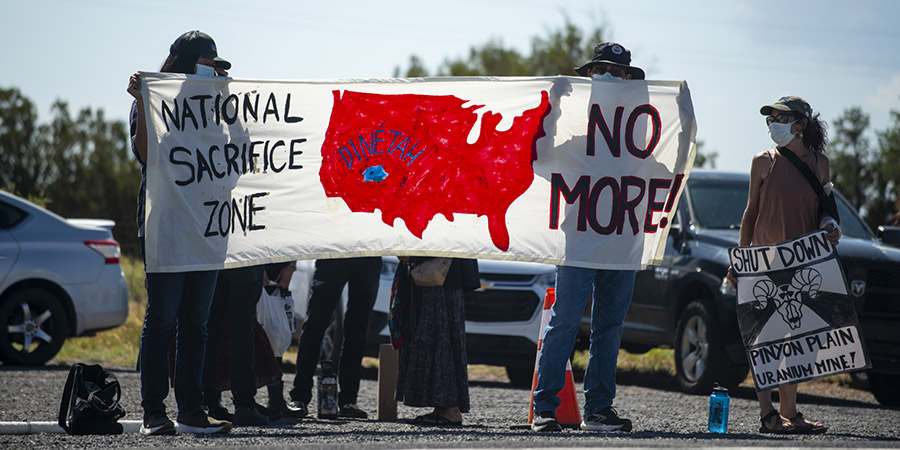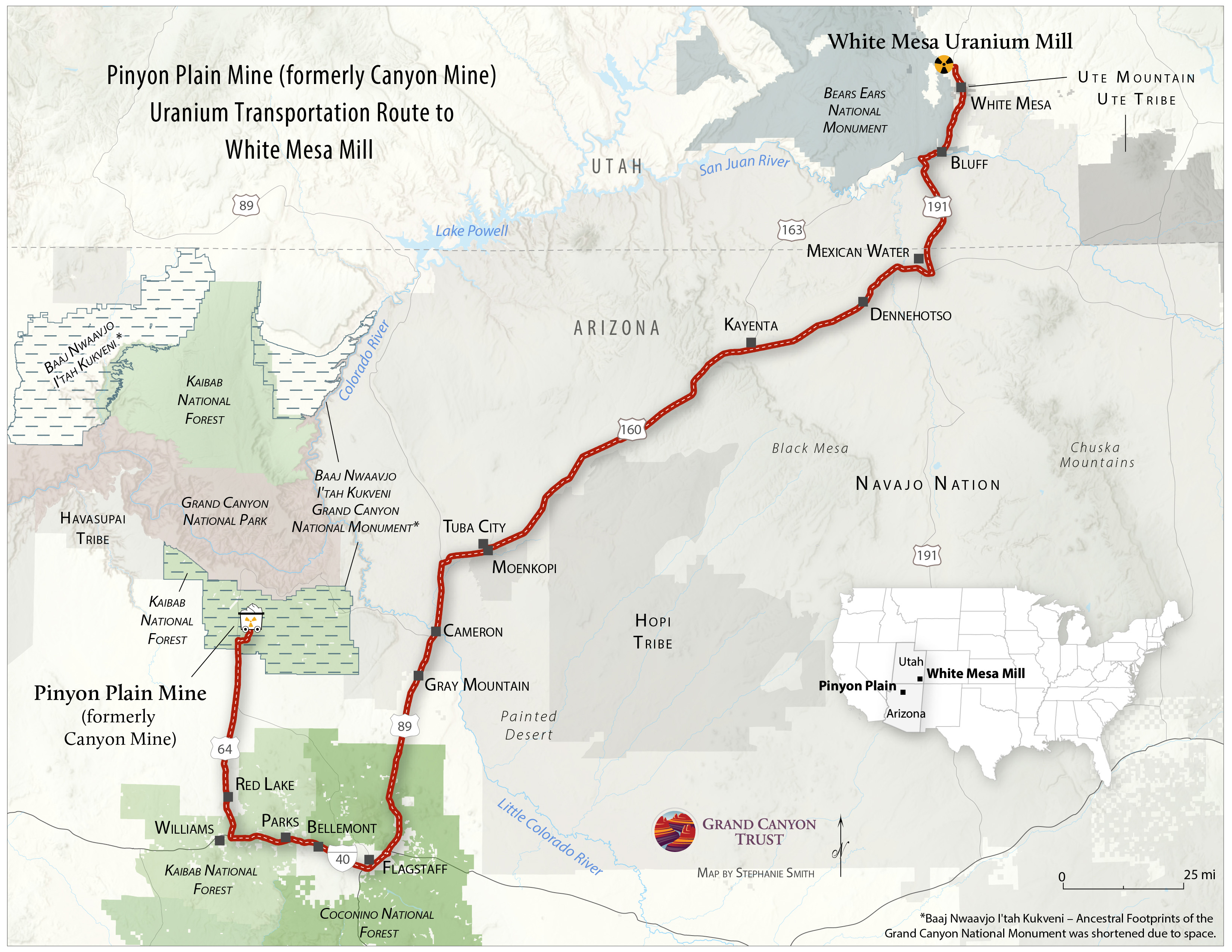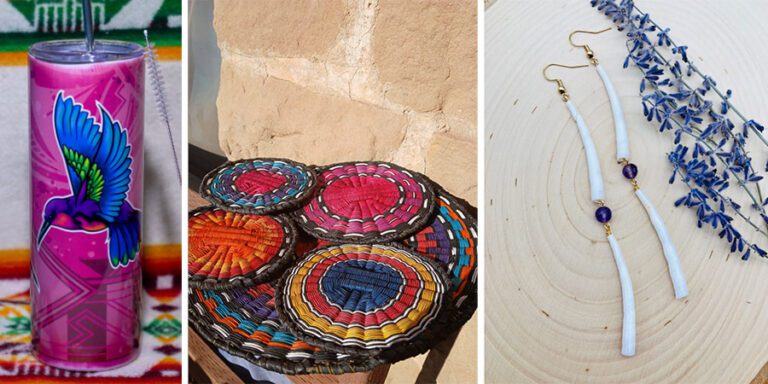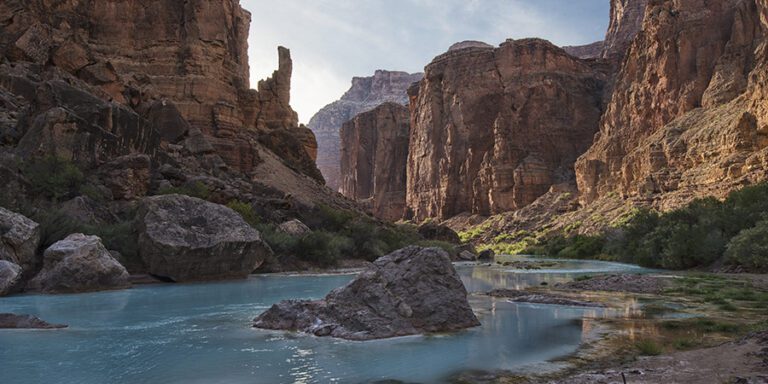
Amid protests, uranium haul trucks pause near the Grand Canyon.
On July 30, 2024, two trucks loaded with uranium ore left a mine near the Grand Canyon headed for the White Mesa uranium mill in southern Utah. The news prompted widespread outcry, spurring a rapid response from the Navajo Nation, Havasupai Tribe, tribal members, and grassroots groups across Arizona, the Navajo Nation, and beyond.
The trucks marked the first loads of uranium ore from Canyon Mine (also known as Pinyon Plain Mine) — a controversial uranium mine located south of Grand Canyon National Park and inside the boundaries of Baaj Nwaavjo I’tah Kukveni – Ancestral Footprints of the Grand Canyon National Monument — to be hauled offsite for processing since the mine began extracting ore in December 2023.
Native American nations had asked to be notified when uranium hauling from the mine began, given ongoing uranium-related health impacts and longstanding concerns about public and environmental safety from communities along the roughly 300-mile haul route. But the news took many in the region by surprise.
Navajo Nation condemns uranium hauling
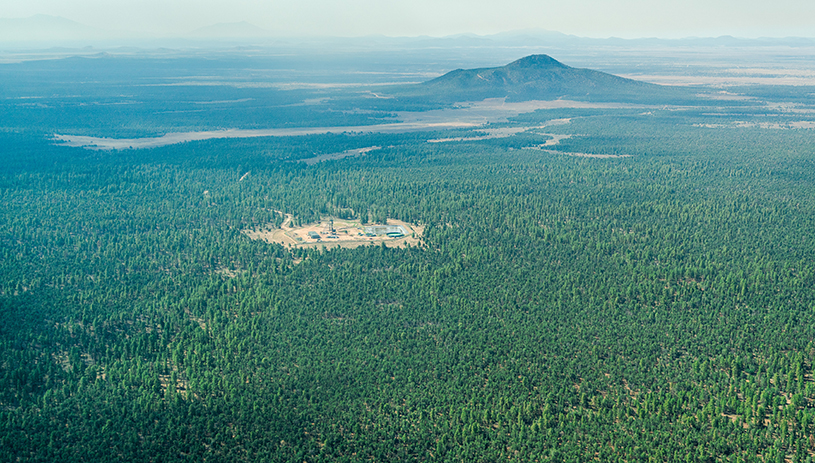
“They snuck through the Navajo Nation,” Navajo Nation President Buu Nygren said in a press release. “[T]hey operated covertly to travel the Navajo Nation illegally…they smuggled uranium across our Nation which is very inappropriate.”
Navajo Nation law bans uranium mining and generally opposes and regulates uranium transport on Navajo lands. President Nygren promised to set up roadblocks to stop uranium haul trucks until the Navajo Nation finishes setting up regulations governing the trucks.
“Our Navajo people have suffered for many years, and many lost their lives due to uranium mining on our homelands. The Navajo Nation will continue to oppose and fight against the transportation of uranium ore through our lands for the health and safety of our people,” vowed Navajo Nation Council Speaker Crystalyne Curley.
The Navajo Nation is still grappling with the legacy of more than 500 abandoned uranium mines, which have contaminated land and water and harmed human health.
Havasupai Tribe condemns uranium hauling
The Havasupai Tribe also issued a scathing statement condemning the hauling as an “attack on the sovereignty of the Havasupai Tribe and neighboring Tribes” and asserting that, by “blatantly disregarding” its promise to notify the tribe when hauling began, mine owner Energy Fuels Resources “has confirmed by its actions today that it cannot be trusted.”
The Havasupai Tribe also reiterated its opposition to the mine, located on the tribe’s aboriginal territory near its sacred mountain, Red Butte, “for the protection of our drinking water and the health and safety of our Tribal members and tourists who visit our reservation.” The tribe said the company’s actions indicate that Energy Fuels Resources is “willing to risk the health and safety of Havasupai Tribal members, Navajo tribal members, and citizens of the State of Arizona.”
The Havasupai Tribe’s world-famous blue-green waterfalls are fed by the Redwall-Muav Aquifer, which lies deep below the mine. The Havasupai Tribe worries that activities at the mine, which has punctured a shallower groundwater aquifer, could contaminate their water supply. At least one recent scientific study has determined uranium mining in the region is too risky.
Protests along the haul route, Arizona governor negotiates temporary pause
On August 2, 2024, Navajo Nation First Lady Jasmine Blackwater-Nygren held a rally in Cameron, followed by a march along U.S. Highway 89, along the haul route.
“I, too, have grandparents who passed from cancer from uranium exposure,” Blackwater-Nygren said. “We are all deeply affected by uranium…Today we’re standing up and saying, ‘Respect our tribal sovereignty, respect our laws.'”
The same day, Arizona Governor Katie Hobbs negotiated a temporary pause to the hauling. Energy Fuels had planned to send six to eight trucks a day from the mine to its Utah mill.
Despite the halted trucks, protests continued over the weekend, calling for the mine to close.
Arizona attorney general weighs in
Meanwhile, Arizona’s attorney general, Kris Mayes, has expressed concern about the mine. “Hauling radioactive materials through rural Arizona, including across the Navajo Nation, without providing notice or transparency and without providing an emergency plan is unacceptable,” Mayes said in a statement.
“I also remain concerned about the potential risks to Arizona’s groundwater associated with the activities of this mine, including the risks posed to the only source of drinking water for the Havasupai Tribe,” Mayes said.
According to Navajo Nation President Nygren, “hauling exposes our Diné people to toxic uranium, a substance that has devastated our community for decades. As president, I do not approve of this transport and will continue to fight to ensure our people are protected from the actions of Energy Fuels,” Nygren promised.
Native nations impacted from mine to mill
Canyon Mine (Pinyon Plain Mine) impacts tribes at every step of the process, from the mining itself, which places water resources and tribes’ traditional homelands at risk, to uranium hauling across tribal lands, to the White Mesa Mill, just up the road from part of the Ute Mountain Ute Reservation, where concerns about water contamination and other long-term health and environmental effects loom over the White Mesa Ute community.
With the situation continuing to evolve, we expect protests will continue as Native nations assert their sovereignty and work to protect their land, water, and people from the devastating effects of uranium mining.

